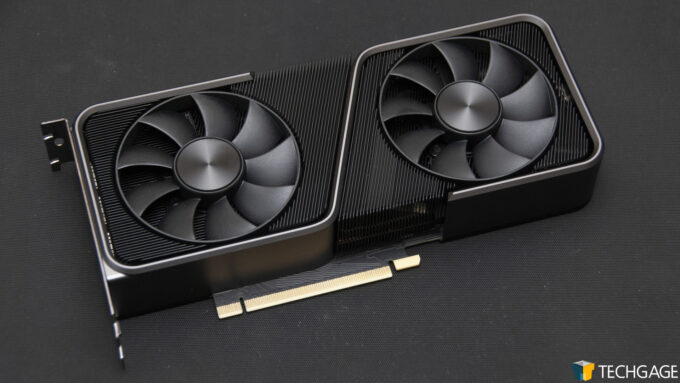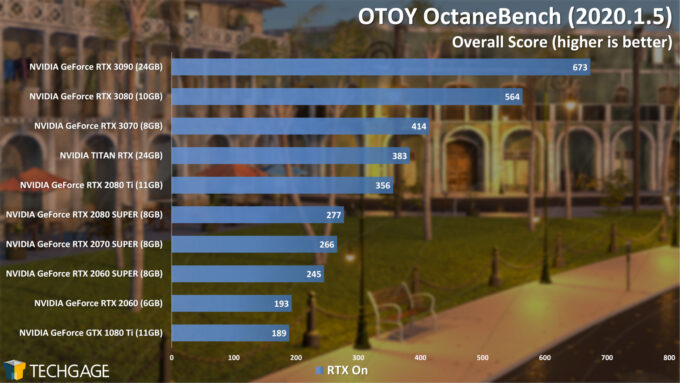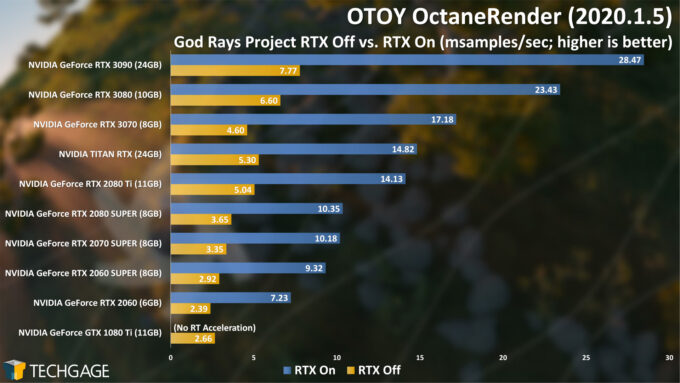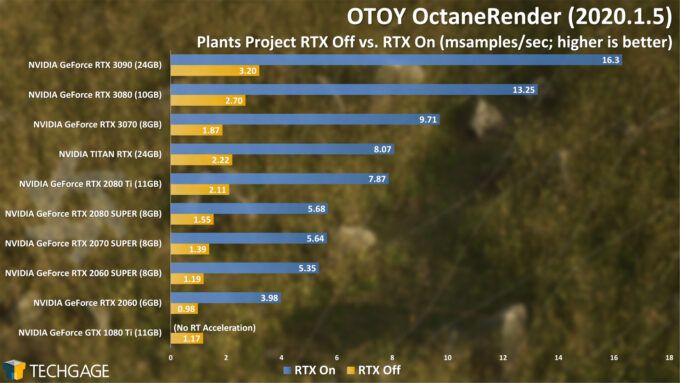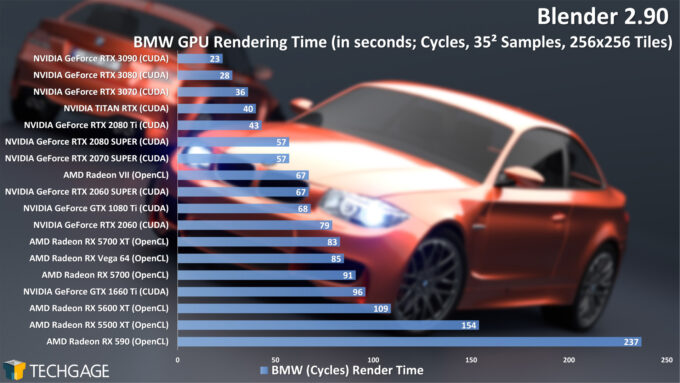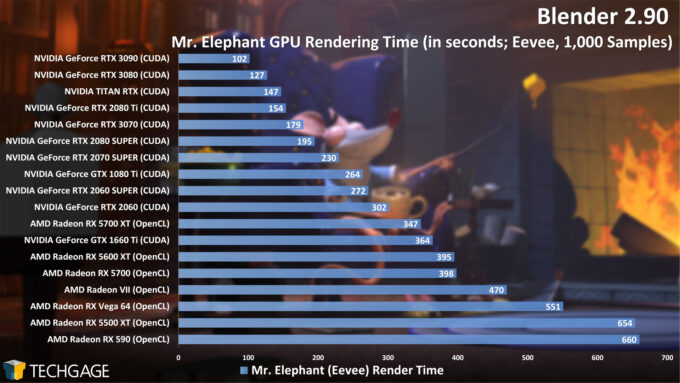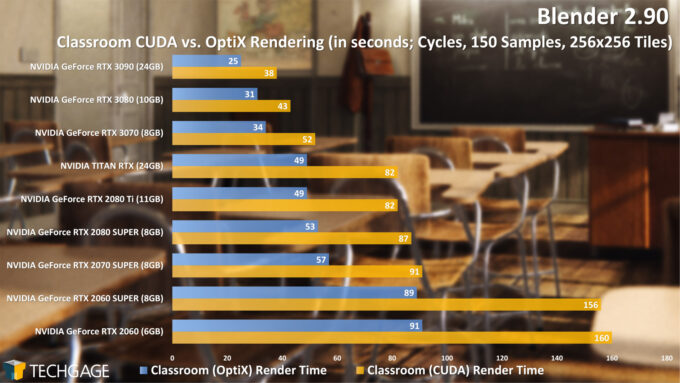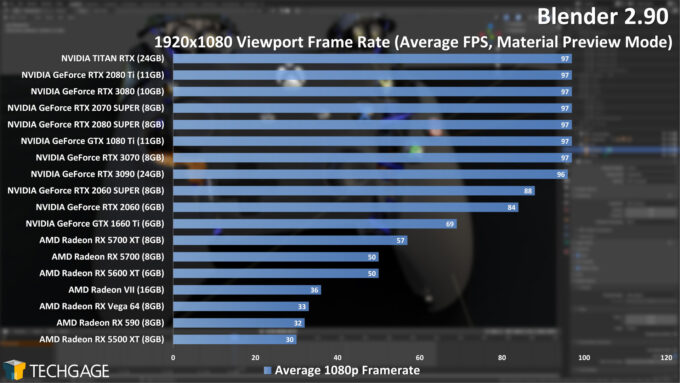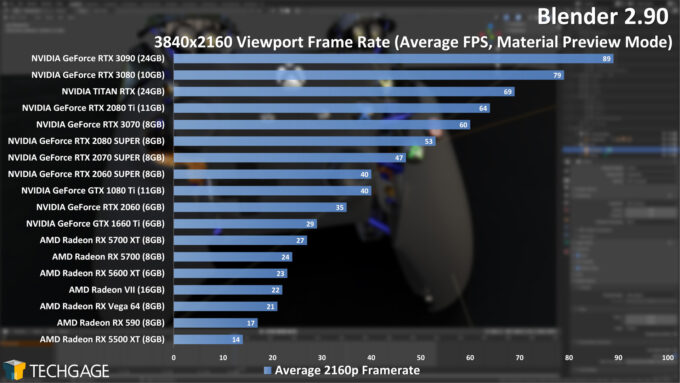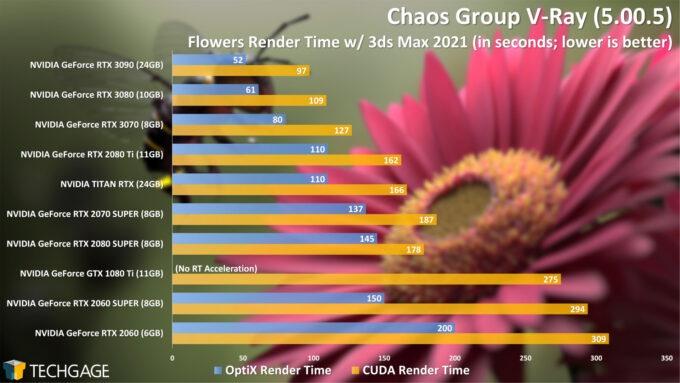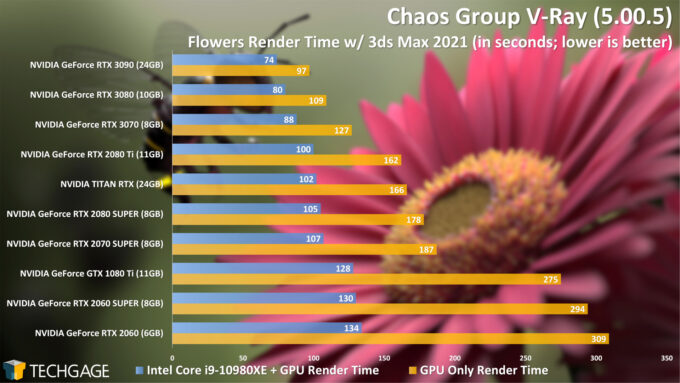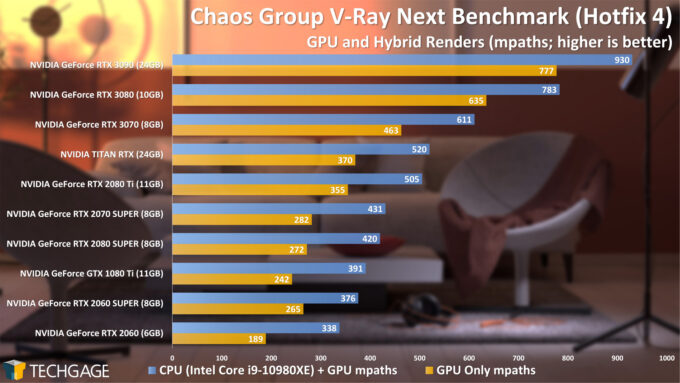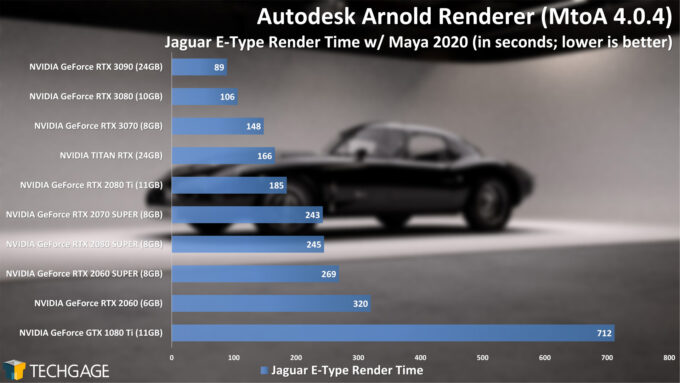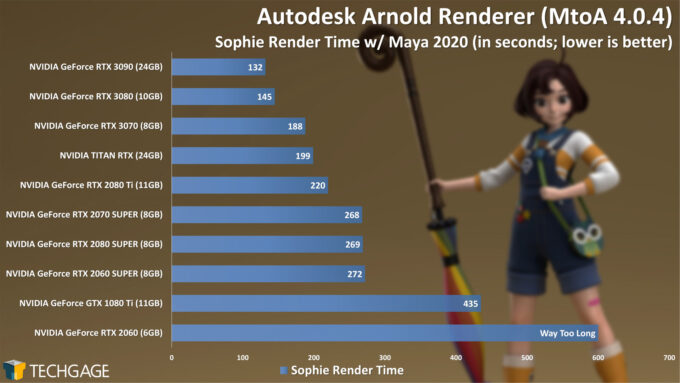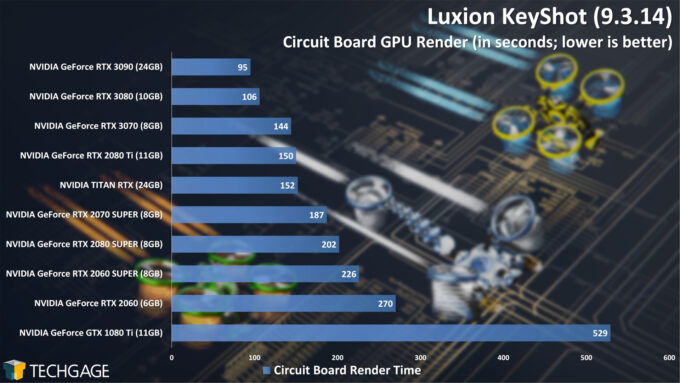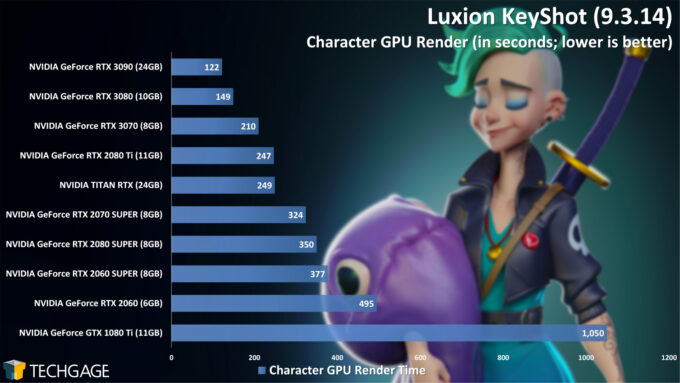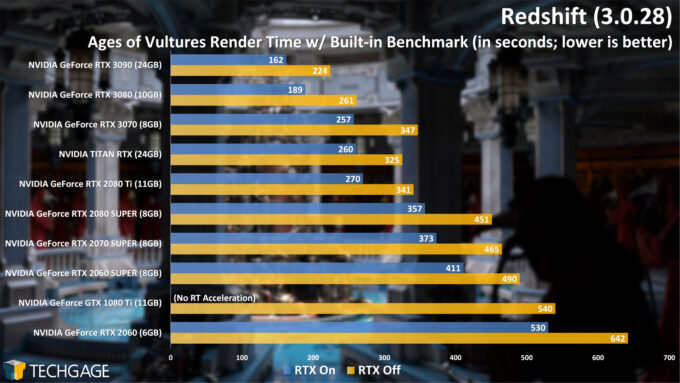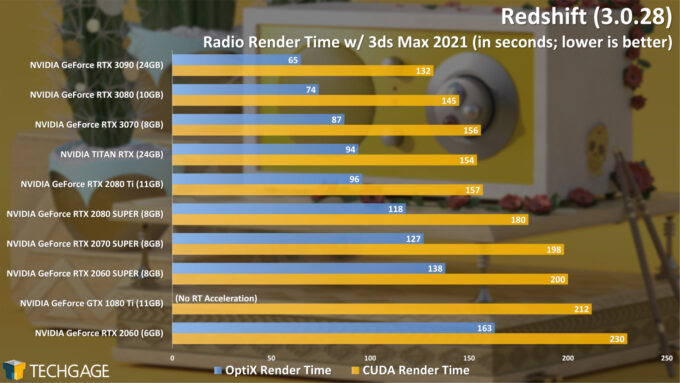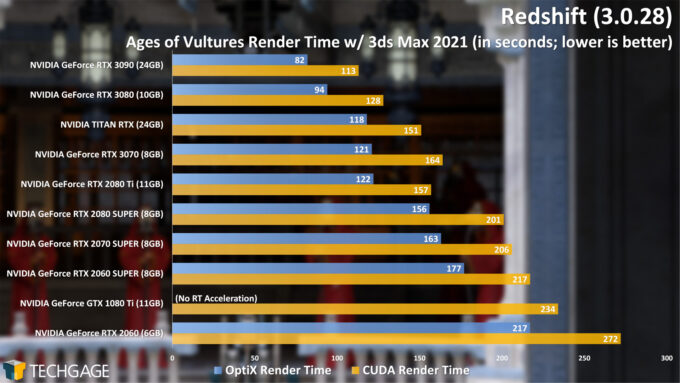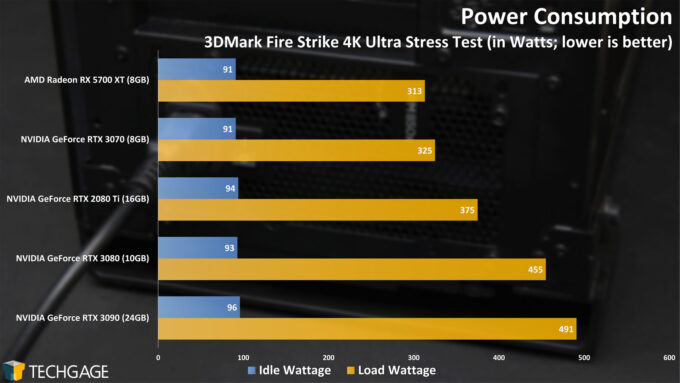- Qualcomm Launches Snapdragon 4 Gen 2 Mobile Platform
- AMD Launches Ryzen PRO 7000 Series Mobile & Desktop Platform
- Intel Launches Sleek Single-Slot Arc Pro A60 Workstation Graphics Card
- NVIDIA Announces Latest Ada Lovelace Additions: GeForce RTX 4060 Ti & RTX 4060
- Maxon Redshift With AMD Radeon GPU Rendering Support Now Available
NVIDIA GeForce RTX 3070 Performance In CUDA & OptiX Rendering
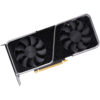
NVIDIA has just launched its third Ampere GeForce, and at $499, the RTX 3070 is going to lure in more folks than the previously released 3090 or 3080. NVIDIA says that its RTX 3070 will match the 2080 Ti in gaming, but to kick our coverage off, we’re going to start with an area where even larger gains can be found: rendering.
The new GeForce RTX 3070 graphics card from NVIDIA doesn’t hold many secrets, largely in part to the fact that the company revealed the specs for its first three Ampere GeForces from the get-go. That even includes the price, which is interesting, because it’s rare when we’re aware of a price more than a month in advance.
Arguably, the RTX 3070 could be considered the most interesting of the three 3000 series cards released so far, because in a single generation, NVIDIA knocked a card like the $1,199 GeForce 2080 Ti down to this $499 RTX 3070. It’s not often we see that kind of price-drop, but it’s obviously a move that will be welcomed by many, since 2080 Ti performance (or better) is now available for far less money.
As we’ve done with the 3090 and 3080 launches, we’re going to kick off our coverage with a look at rendering performance here, exclusively in those renderers that revolve their lives around CUDA and OptiX – with the exception of Blender, which is our only test here to include Radeon GPUs.
There’s not too much to talk about here that hasn’t been discussed ad nauseam over the last number of articles, but for those interested, here’s a breakdown of NVIDIA’s current lineup (including 1080 Ti for reference):
| NVIDIA’s GeForce Gaming GPU Lineup | |||||||
| Cores | Base MHz | Peak FP32 | Memory | Bandwidth | TDP | SRP | |
| RTX 3090 | 10,496 | 1,400 | 35.6 TFLOPS | 24GB 1 | 936GB/s | 350W | $1,499 |
| RTX 3080 | 8,704 | 1,440 | 29.7 TFLOPS | 10GB 1 | 760GB/s | 320W | $699 |
| RTX 3070 | 5,888 | 1,500 | 20.4 TFLOPS | 8GB 2 | 512GB/s | 220W | $499 |
| TITAN RTX | 4,608 | 1,770 | 16.3 TFLOPS | 24GB 2 | 672 GB/s | 280W | $2,499 |
| RTX 2080 Ti | 4,352 | 1,350 | 13.4 TFLOPS | 11GB 2 | 616 GB/s | 250W | $1,199 |
| RTX 2080 S | 3,072 | 1,650 | 11.1 TFLOPS | 8GB 2 | 496 GB/s | 250W | $699 |
| RTX 2070 S | 2,560 | 1,605 | 9.1 TFLOPS | 8GB 2 | 448 GB/s | 215W | $499 |
| RTX 2060 S | 2,176 | 1,470 | 7.2 TFLOPS | 8GB 2 | 448 GB/s | 175W | $399 |
| RTX 2060 | 1,920 | 1,365 | 6.4 TFLOPS | 6GB 2 | 336 GB/s | 160W | $299 |
| GTX 1660 Ti | 1,536 | 1,500 | 5.5 TFLOPS | 6GB 2 | 288 GB/s | 120W | $279 |
| GTX 1660 S | 1,408 | 1,530 | 5.0 TFLOPS | 6GB 2 | 336 GB/s | 125W | $229 |
| GTX 1660 | 1,408 | 1,530 | 5 TFLOPS | 6GB 4 | 192 GB/s | 120W | $219 |
| GTX 1650 S | 1,280 | 1,530 | 4.4TFLOPS | 4GB 2 | 192 GB/s | 100W | $159 |
| GTX 1650 | 896 | 1,485 | 3 TFLOPS | 4GB 4 | 128 GB/s | 75W | $149 |
| GTX 1080 Ti | 3,584 | 1,480 | 11.3 TFLOPS | 11GB 3 | 484 GB/s | 250W | $699 |
| Notes | 1 GDDR6X; 2 GDDR6; 3 GDDR5X; 4 GDDR5; 5 HBM2 GTX 1080 Ti = Pascal; GTX/RTX 2000 = Turing; RTX 3000 = Ampere |
||||||
Versus the 2080 Ti, the new RTX 3070 draws much less power overall – about 30W less on paper. The biggest difference beyond that is that the 3070 loses 3GB of the Ti’s frame buffer, but for a card that costs much less than the Ti, we’re not sure many will complain. That’s especially so as the 3070 will definitively beat out the Ti in rendering in most every case, thanks to the ray tracing performance improvements seen with the Ampere architecture.
It’s worth noting that like the bigger GPUs, the RTX 3070 includes the new mini 12-pin power connector. Unlike those bigger cards, however, NVIDIA included a special single cable converter for this GPU, instead of the Y split adapter like the others. Even then, only half of those 12 pins are populated, so it’s clear that this is not going to be a very power-hungry GPU. We’ll let others evaluate whether or not the modest power implementation impacts overclocking at all.
To be clear, we have gaming testing en route, and at this point, it’s effectively half-finished. We’re taking advantage of being able to launch with a ProViz look while the rest of the testing gets completed in the background, so if you’re interested in the gaming aspect of this card, please stay tuned. For now, here’s a look at the current workstation GPU test system:
| Techgage Workstation Test System | |
| Processor | Intel Core i9-10980XE (18-core; 3.0GHz) |
| Motherboard | ASUS ROG STRIX X299-E GAMING |
| Memory | G.SKILL FlareX (F4-3200C14-8GFX) 4x8GB; DDR4-3200 14-14-14 |
| Graphics | NVIDIA RTX 3090 (24GB, GeForce 456.38) NVIDIA RTX 3080 (10GB, GeForce 456.16) NVIDIA RTX 3070 (8GB, GeForce 456.96) NVIDIA TITAN RTX (24GB, GeForce 452.06) NVIDIA GeForce RTX 2080 Ti (11GB, GeForce 452.06) NVIDIA GeForce RTX 2080 SUPER (8GB, GeForce 452.06) NVIDIA GeForce RTX 2070 SUPER (8GB, GeForce 452.06) NVIDIA GeForce RTX 2060 SUPER (8GB, GeForce 452.06) NVIDIA GeForce RTX 2060 (6GB, GeForce 452.06) NVIDIA GeForce GTX 1080 Ti (11GB, GeForce 452.06) |
| Audio | Onboard |
| Storage | Kingston KC1000 960GB M.2 SSD |
| Power Supply | Corsair 80 Plus Gold AX1200 |
| Chassis | Corsair Carbide 600C Inverted Full-Tower |
| Cooling | NZXT Kraken X62 AIO Liquid Cooler |
| Et cetera | Windows 10 Pro build 19041.329 (2004) |
| All product links in this table are affiliated, and help support our work. | |
OTOY OctaneRender 2020
We start with a result that might make some 2080 Ti owners scratch their head a little bit, especially if they happened to have purchased one in recent months. The lowly $499 RTX 3070 manages a score that’s 16% higher over the RTX 2080 Ti. Naturally, the 8GB frame buffer might be a limitation for some, but there’s no denying that some serious generational improvement has been made here.
Let’s see how that carries over to some real OctaneRender projects:
These real-world results actually expose something interesting. In both cases, it seems clear that the 11GB frame buffer allows the 2080 Ti to get work done a little more efficiently, as the RTX Off render test crown belonged to 2080 Ti, whereas turning RTX On gave the RTX 3070 the kind of lead we expected. In this case, RTX On resulted in a score boost of 23% over the 2080 Ti – even better than what we saw with OctaneBench.
Blender 2.90
The RTX 3070 continues to flaunt its capabilities well against the 2080 Ti here. Whereas the Ti managed to surpass the 3070’s RTX Off performance in OctaneRender, the opposite is true here. Where the 2080 Ti rendered this BMW test in 43 seconds, the 3070 shaved that down to 36. Let’s see how that carries over to Eevee:
Well, well, well. What do we have here? We have the first test result that shows the new RTX 3070 lagging behind the 2080 Ti, hinting that our Eevee render might take better advantage of more memory than we realized. Eevee doesn’t take advantage of ray tracing acceleration like Cycles can, or else we may have seen some stronger performance out of the 3070 here. That’s not to say what we see is poor – not by any stretch. With its positioning, the RTX 3070 obliterates everything under RTX 2080 Ti.
With a return to the Cycles renderer and the Classroom project, we see the RTX 3070 manage to pull ahead of the RTX 2080 Ti again, in either CUDA or OptiX (RTX On) rendering. It’s OptiX where AMD will likely have a difficult time competing with its next-gen Radeons, unless we’re in for some surprises.
Even if AMD managed to largely catch up (or perhaps beat) NVIDIA’s CUDA rendering performance a bit, the fact that RT acceleration exists will likely rain on the company’s parade. Without RT acceleration, the 3070 would settle on a render time of 52 seconds, but because it exists, that’s instead cut down to 34 seconds. That’s hardly a small difference.
Let’s check out viewport performance:
The 1080p test makes it obvious that we should be introducing a second more strenuous project to give us some different perspectives, because the CPU is clearly a bottleneck at that resolution. For that reason, we’re interested in seeing if AMD’s upcoming Zen 3 processors might break through this bottleneck a little bit, especially since AMD’s chips have been favorable to Blender in the past few years (at least on the CPU side).
At 4K, the RTX 3070 once again sits behind the 2080 Ti, but it manages to keep pegged to around 60 FPS, which is more than enough for this type of work. You could even get by with 30 FPS here, so it’s not as though half of the stack under-performs – unless we’re talking about the truly low-end parts.
Chaos Group V-Ray 5
V-Ray shows off the RTX 3070 in quite a nice light, with both of the CUDA and OptiX renders showing huge performance gains over the RTX 2080 Ti. The fact that the 3070 keeps pegged to near the top of the chart in each result is really telling, because it’s quite a good placement for a GPU that costs a clean $500. As before, once you enable OptiX, you gain even more of your time back.
The chart above shows that if you have a powerful CPU, you could take advantage of heterogeneous rendering as well to speed things up, but as you will be able to see when comparing the two sets of results, OptiX can negate the need to introduce the CPU. Whereas our 18-core CPU combined with RTX 3090 rendered this project in 74 seconds, using OptiX instead drops that to 52 seconds. If you have a small CPU, you’re likely to see even greater performance deltas.
While V-Ray’s standalone benchmark is based on the older 4.X version, it still scales well with current hardware, as evidenced above. Even without current-gen optimizations, the RTX 3070 topples the RTX 2080 Ti handily here, yet again placing third among the entire lineup, only behind its bigger siblings.
Autodesk Arnold 6
Arnold seems to love memory, so the 8GB attached to the RTX 3070 should prove sufficient for many users. Based on previous-gen performance, had this RTX 3070 only included 6GB of memory, then these projects would struggle to render, which is why you see the RTX 2060 noted as “Way Too Long” in the Sophie render (the actual time was something around 1,500 seconds).
Yet again, the RTX 3070 shines here, easily placing ahead of the 2080 Ti, and we guess it’s fair to say ahead of the TITAN RTX, as well. That GPU has a bit of a memory advantage, but even so, these results continue to look great for NVIDIA’s new card.
Luxion KeyShot 9
We had considered testing KeyShot 10’s beta for this article, but time got the best of us, so that will instead come in the near-future (although not likely the beta, since the final version is due soon.) Nonetheless, we continue to see the RTX 3070 deliver super-strong performance here, again beating out the top-end GPUs of last generation.
These results highlight why we like to test with multiple projects. In the Circuit Board render, the RTX 370 placed modestly ahead of the RTX 2080 Ti, but the Character project showed a much more impressive performance improvement.
Maxon Redshift 3
Are you getting tired of the same RTX 3070 positioning yet? Time after time, the RTX 3070 is almost guaranteed to place ahead of the last-gen TITAN RTX and 2080 Ti, which means those who’ve been holding out on a new GPU are going to be blessed with a ton of performance for their buck. That also applies to the RTX 3080, because for $200 more, that GPU actually does pull ahead a fair bit.
As we saw with OctaneRender earlier, the RTX Off renders showed the RTX 3070 to lag behind both the TITAN RTX and 2080 Ti, but with RTX turned on, the new card pulls ahead ever-so-slightly.
Here’s some backup tests using 3ds Max:
With these real-world tests, we’re seeing similar performance as with the benchmark, with the RTX 3070 not exactly beating TITAN RTX or 2080 Ti definitively, but it at least keeps super-close. Again, we’re seeing a $500 GPU behave like last-gen’s $1,200 one. That is all sorts of impressive.
Power Consumption
For this round of testing, we retested the power consumption of our GPUs, but as you can see, we haven’t exactly cleared through much of the collection quite yet. Still, we have the most important GPUs included here, and see that the RTX 3070 draws about 50W less than the RTX 2080 Ti, despite the rated TDP difference only being 30W apart.
Another interesting angle is that the RTX 3070 barely uses any more power over the RX 5700 XT, yet it absolutely smashes it in terms of performance. We really can’t wait for the next-gen Radeon GPUs to see AMD try to strike back against the powerful Ampere GPUs we’re dealing with here.
Final Thoughts
In the end, NVIDIA’s GeForce RTX 3070 performs about where we’d expect it to, based on what we knew of the card before diving in. NVIDIA itself said that the RTX 3070 would match 2080 Ti, and in our gaming tests so far, we’ve found that to be largely the case (although we seem to see Ti pulling ahead more often than the opposite is true.) Again, we’ll have that performance in the days ahead, as we wrap up our testing (which will include 1440p, ultrawide, and 4K test resolutions.)
It’s become a theme that we kick off a new launch with creator-focused content, but with the RTX 3070, it seems to almost make sense that we start here. Whereas the RTX 3070 will largely match the RTX 2080 Ti in gaming, it’s almost guaranteed to take a clear lead in creator.
We saw some instances where the 2080 Ti still managed to take the lead, but it was never by very much, and it could be owed in some cases to the larger frame buffer. If you can survive your work with a 8GB frame buffer, then the RTX 3070 is a seriously attractive creation graphics card. As mentioned multiple times earlier, this card costs less than half what the 2080 Ti did, but often beats it in rendering.
Quite simply, the RTX 3070 offers more performance than a $500 GPU ever has before. If we look as far back as the Pascal-based 1080 Ti, that card scored 189 points in OctaneRender, whereas this RTX 3070 scored 414. In our real-world tests, we generally see the RTX 3070 at least twice as fast as the 1080 Ti, and it still costs less than that card did at its launch a few years ago.
All three Ampere cards have been interesting or exciting in their own right, but the RTX 3070 sets itself apart due to its more accessible price-point and its performance advantages over the last-gen parts. $500 GPU for $500 GPU, the RTX 3070 is 55% faster than the 2070 SUPER from last-gen, so overall, NVIDIA has quite an alluring product here.
We promised before that this launch article would include much more than rendering, but we’ve been still churning through tests for that, and are still planning a fuller overall look at ProViz performance in the weeks ahead. Stay tuned for that, and in the meantime, if you have further questions, please post them below.
Support our efforts! With ad revenue at an all-time low for written websites, we're relying more than ever on reader support to help us continue putting so much effort into this type of content. You can support us by becoming a Patron, or by using our Amazon shopping affiliate links listed through our articles. Thanks for your support!




